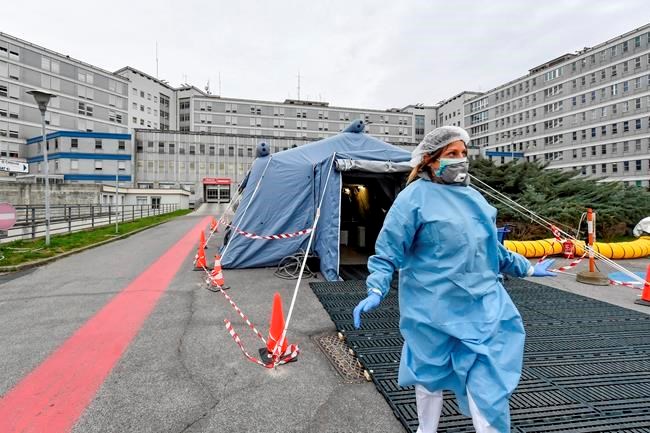ROME — Italian doctors celebrated one small victory in their battle against the coronavirus after a 38-year-old man was moved out of intensive care for the first time since he tested positive Feb. 21 and opened Italy’s health care crisis as Patient No. 1.
But in the rest of hard-hit northern Italy, the virus’ spread was growing so exponentially that doctors were making comparisons to war-time triage medics deciding who lives, who dies and who gets access to the limited number of ICU beds.
“It’s a reasoning that our colleagues make," Dr. Guido Giustetto, head of the association of doctors in northern Piedmont, said Monday. “It becomes dramatic if, rather than doing it under normal situations, they do it because the beds are so scarce that someone might not have access to medical care.”
The Italian society of anesthesiology and intensive care published 15 ethical recommendations to consider when deciding on ICU admissions during the virus crisis and the ICU shortage. The criteria include the age of the patient and the probability of survival, and not just “first come first served.”
The Lombardy government has been scrambling to increase its ICU capacity, converting operating and recovery rooms into isolated wards to treat the 440 critical virus patients currently in need. It has cobbled together 150 more beds in the last two weeks and expects another 150 in the coming week.
But it may not be enough.
“Unfortunately we’re only at the beginning,” said Dr. Massimo Galli, head of infectious disease at Milan’s Sacco hospital. Speaking to SkyTg24, Galli noted that the numbers of infections registered in Lombardy last week were similar to those in Wuhan, China in late January.
Galli noted that Wuhan, the
On Monday, the government took broad new measures to restrict Italians' movements nationwide and prevent social gatherings, realizing that limited restrictions weren't containing the spread. For example, the region surrounding the capital Rome — Lazio — saw its cases jump from 87 to 102 in a day, a sign that the virus was propagating far from the northern concentrations.
Also alarming was Italy’s high fatality rate: With 463 dead and 9,172 infected, Italy’s fatality rate is running at 5% nationwide and 6% in Lombardy, far higher than the 3%-4% estimates elsewhere.
Dr. Giovanni Rezza, head of infectious disease at the National Institutes of Health, attributed the high rate to the fact that Italy has the world’s oldest population after Japan, and the median age of its virus-related dead is 80.
But there are young people who are infected too. Some have been in intensive care, including the first person to test positive in the north who hadn’t been to China, a 38-year-old Unilever worker named Mattia. He came to be known in Italy as Patient No. 1.
At the San Matteo hospital in Pavia, there was a sigh of relief after Mattia began breathing on his own Monday with just a small amount of oxygen assistance, said Dr. Francesco Mojoli, head of intensive care. He was moved out of the ICU to a sub-ICU unit and was speaking with doctors.
“This disease has a long life,” Mojoli told RAI state television. “Now we hope that the fact that he was young and in good shape will help him get back to his normal life.”
Mattia first went to the hospital in Codogno on Feb. 18 complaining of flu-like symptoms. He was sent home but came back the next day after his condition worsened dramatically. He was only tested for coronavirus after doctors learned that in early February he had met with a man who had been to China.
By then, however, he had infected his wife and several doctors, nurses and patients at the Codogno hospital, creating what was thought initially to have been Italy’s main cluster. Since his China contact turned out to be negative, though, experts now believe that the virus had been circulating widely and quietly in northern Italy since at least the second half of January.
The epidemic has exposed the impact of drastic cuts to Italy's public health system over the past few years, and prompted calls for the government to authorize hiring of thousands of doctors and nurses. In Lombardy, nursing students were allowed to graduate a month early so they could be put to work immediately.
Over the weekend, a nurse named Doris Bia posted on Facebook that after taking a leave for several years to be a full-time mother, she was going back to work at the Oglio Po hospital in hard-hit Cremona.
“Starting tomorrow I’ll be beside those who are untiringly fighting this god-forsaken virus,” she wrote. “I’m doing it because I can’t ignore their sacrifice.”
Nicole Winfield, The Associated Press



